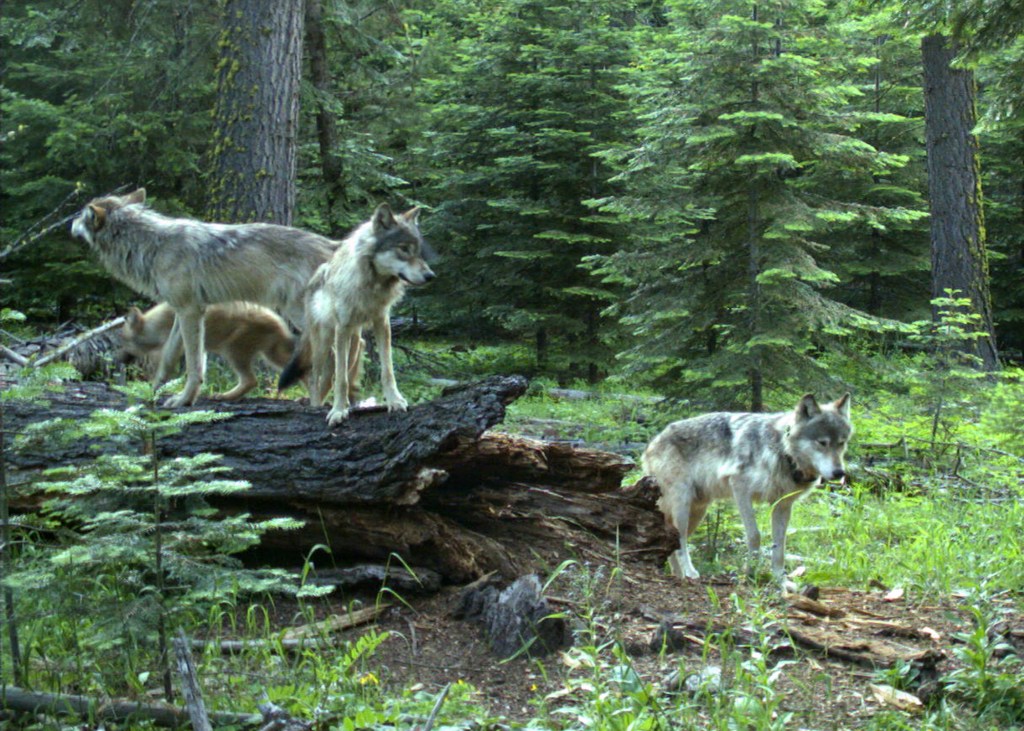Oregon estimated wolf population up 15% in 2024
Published 3:25 pm Thursday, April 17, 2025

- Wolves from the Frazier Mountain Pack, including a pup born in 2023, caught on a trail camera in June 2023 near their den on private lands in Union County. (Oregon Department of Fish and Wildlife).
SALEM — Oregon’s estimated wolf population grew by about 15% in 2024, rising from 178 to 204 animals, according to the annual wolf conservation and management report released April 11 by the Oregon Department of Fish and Wildlife.
The agency counted wolves statewide at the end of 2024.
According to the report, the number represents the minimum number of wolves in the state, as not all animals can be located during the winter count.
“The actual number of wolves in Oregon is higher than this minimum count,” the report states.
It was the first increase in the estimated wolf population in two years. ODFW pegged the minimum population at 178 at the end of 2022 and 2023.
A total of 25 wolf packs were documented statewide, up from 22 in 2023. Seventeen of those packs met the criteria of having a breeding pair. Another 18 groups of wolves consisted of two or three animals but did not meet the definition of a pack, which is four or more wolves traveling together in winter.
Other than the population, there was relatively little change in several other wolf statistics.
As has been the case since wolves migrated into the state from Idaho in 1999, the majority of the animals live in the northeast corner of Oregon.
In 2024, about 76% of wolves counted in Oregon were in the east management zone, and the majority of those in Northeastern Oregon.
There were 18 packs in the east zone, one more than in 2023.
Thirteen wolves were counted, either alone or in pairs, in Baker, Crook, Deschutes, Grant, Umatilla, Union and Wheeler counties. Those wolves “may be the start of new packs or disperses traveling through the area,” according to the report.
The wolf population also continues to grow in south-central and western Oregon. The number of breeding wolf pairs in that region increased in 2024 from three to seven, with five of those pairs creating new packs.
Wolves in Oregon east of Highways 395, 78 and 395 — roughly the eastern one-third of the state — are not protected under the federal Endangered Species Act. Wolves in that region are managed by the state.
Wolves west of those highways are federally protected.
State Sen. Todd Nash, R-Enterprise, has said he’d like to remove federal protection for wolves across Oregon.
Wolf deaths and wolf attacks on livestock
ODFW confirmed 69 wolf attacks on livestock statewide in 2024, compared with 73 in 2023. Most (77%) of the attacks were on private land. About 46% of wolf packs attacked livestock, with five packs having five or more depredations.
Most of the livestock attacks — 58 of 69 — were in the east management zone.
State or federal agents killed 11 wolves that had chronically attacked livestock, all in the east zone, in 2024. Livestock owners killed three other wolves that were attacking livestock.
A total of 26 wolf deaths were documented in 2024 in the eastern zone, including 22 that were human-caused. One dispersing wolf was killed by a car on Interstate 84 in Union County.
Oregon State Police are investigating six wolf deaths in the east zone, including two that were shot, one from the Logan Valley Pack in Grant County, and one along the upper Imnaha River in Wallowa County.
Four wolves died from poison, including three from the South Snake Pack, including both the breeding male and female, and the breeding male from the Wenaha Pack in Wallowa County.
Joseph Vaile, senior representative to the Northwest program at Defenders of Wildlife, called the 15% increase in the state’s estimated wolf population “promising,” but he said the annual report “highlights a pressing issue — illegal poaching is preventing the state from meeting its recovery goals in western Oregon. Oregon must do more to reduce human-caused mortality or wolves will never fully recover.”
Financial compensation for wolf attacks
The Oregon Department of Agriculture’s compensation program for wolf attacks on livestock awarded grants totaling $789,565 to 13 counties in 2024. The majority of the money (61%) was used for nonlethal preventive measures, but all requests for compensation of confirmed and probable attacks on livestock were granted in full.
The top four counties, in dollars received for livestock attacks, are all in Northeastern Oregon:
• Grant, $37,500
• Wallowa, $29,969
• Baker, $23,096
• Union, $14,850
The rankings were similar for compensation for missing livestock, except Klamath County was also in the top five.
• Wallowa: $60,622
• Grant: $37,807
• Union: $26,982
• Klamath: $23,075
• Baker: $13,543
Nash supports Senate Bill 777, which is under consideration in the Legislature. The bill would increase substantially the financial compensation from the state to ranchers who have livestock killed by wolves. The bill is now in House Committee on Agriculture, Land Use, Natural Resources and Water sponsored by Rep. Bobby Levy, R-Echo.
SB 777 would reimburse livestock producers five times the market value of calves, sheep and goats and twice the value of cows. Working dogs and horses continue to be reimbursed at one-to-one value, as is the case for all animals under current law.






